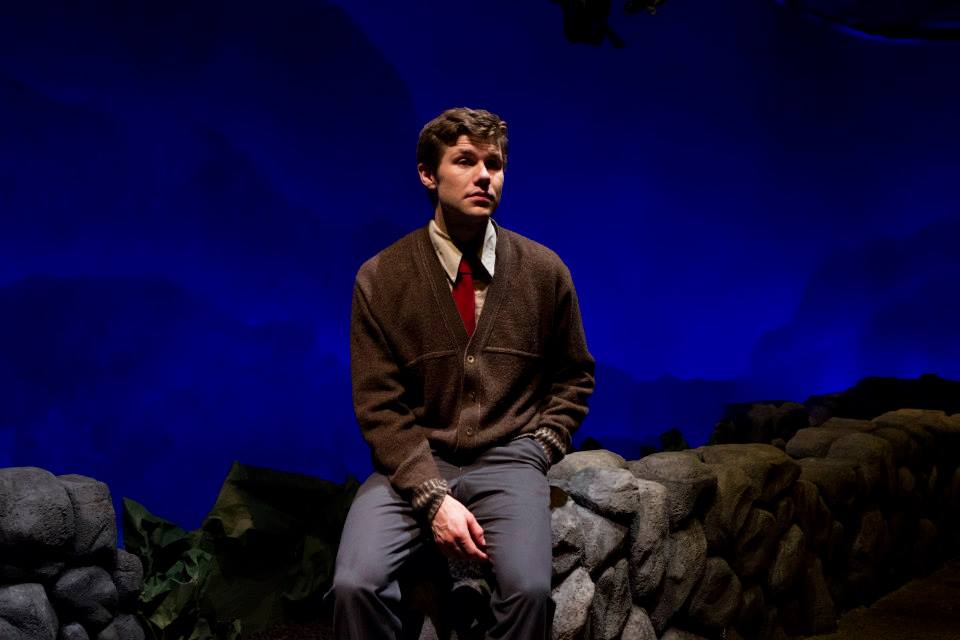
Patrick Stanny ’15
Discovering Harmony in Ballybeg
By: Ziggy Schulting ’18
This fall, upon entering the Janet Kinghorn Bernhard Black Box theater, the audience found themselves in mystical Donegal, Ireland in the year 1936. They stepped on woodchips as they entered the Mundy household, but still managed to get a glimpse of the lush Irish hills in the background and green vegetation permeating the foreground. The black box had been transformed into the fictional town of Ballybeg and took onlookers back almost 80 years.
This transportation was at the heart of the Skidmore Theater Department’s fall black box production: Brian Friel’s Dancing at Lughnasa, directed by Marie Glotzbach. This Irish masterpiece explores the fragile harmony among five grown sisters living in the rural County Donegal. Friel’s memory play is told from the point of view of the adult Michael Evans (Patrick Stanny ’15) who recounts the summer in his aunts’ cottage when he was seven years old.
Friel, born in 1929, is considered one of the greatest living English-language dramatists. The English-speaking world often refers to him as the “Irish Checkov” and “universally accented voice of Ireland.” Though Friel has written more then thirty plays in six decades and has been featured on Broadway, he is best known for his plays Philadelphia, Here I Come! and Dancing at Lughnasa, the latter of which truly brought Friel international acclaim, winning him several Tony Awards, including Best Play.
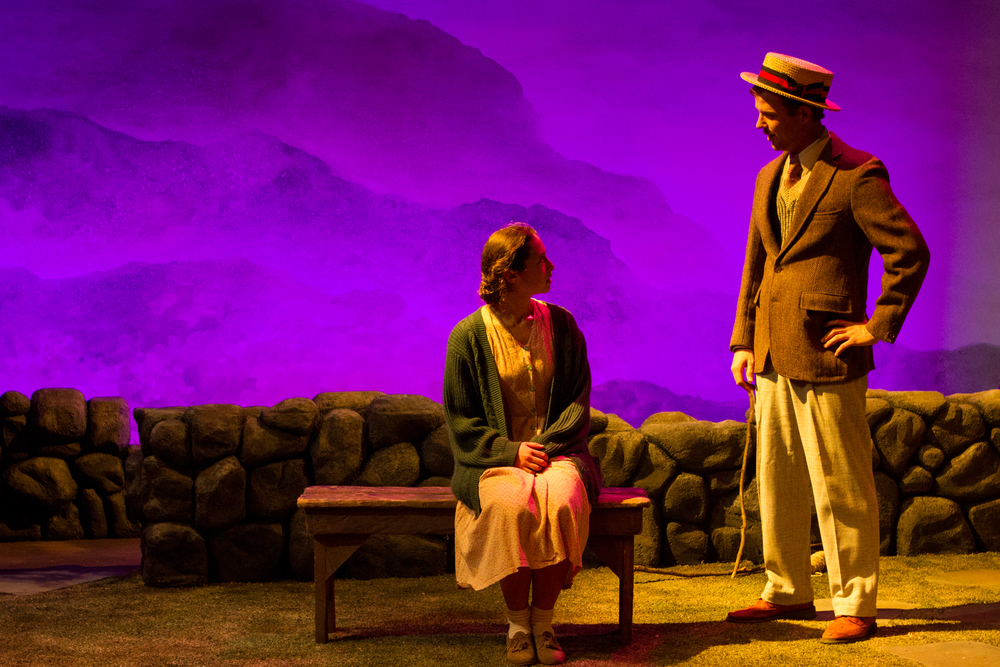
Alex Chernin ’15 and John Noble Barrack ’15
While it seems abundantly clear that Friel is unparalleled in his field, what served to bring this particular production to life was the stunning cast and crew. The intimate cast of eight brought the dynamic and complicated relationships of Friel’s characters to life. The five Mundy sisters, Kate (Hallie Christine ’15), Maggie (Lily Donahue ’15), Agnes (Becca Zipursky ’15), Rose (Sierra Fritz ’17), and Chris (Alex Chernin ’15), all worked together to care for Michael and create a sincere family dynamic that brought warmth to the stage.
But Michael is not the only male who shapes the Mundy sisters’ lives that summer. The sisters’ beloved Uncle Jack (David Bunce who appears courtesy of Actors’ Equity) and Michael’s father, Gerry (John Noble Barack ’15), also reenter the Mundy household and act as a catalyst for the chaos that ensues. While Gerry does seem to cause much friction among the sisters, Barrack was able to understand and relate to the complexity of his character, “[Gerry] was always moving around, finding different jobs. He is looking for his own home. As a college student about to go off into the real world, I’m also in search of home and a place where I can settle down. I believe that is where Gerry and I meet.”
At the core of Dancing at Lughnasa is the idea of maintaining home and family in an ever-changing reality. For Christine, who played the role of strict, pious Kate, home in Dancing at Lughnasa means a combination of family, time, and story telling: “Everybody is working to keep this family together, but we know that in time they will all be separated. Everybody is trying to understand where their story fits into the family, and where the family fits into time.” Friel’s characters not only have specific stories, but also specific identities which were marked by a few memorable and stunning performances, such as the fun-loving Maggie and the developmentally disabled Rose, brought to life by Donahue and Fritz, respectively.
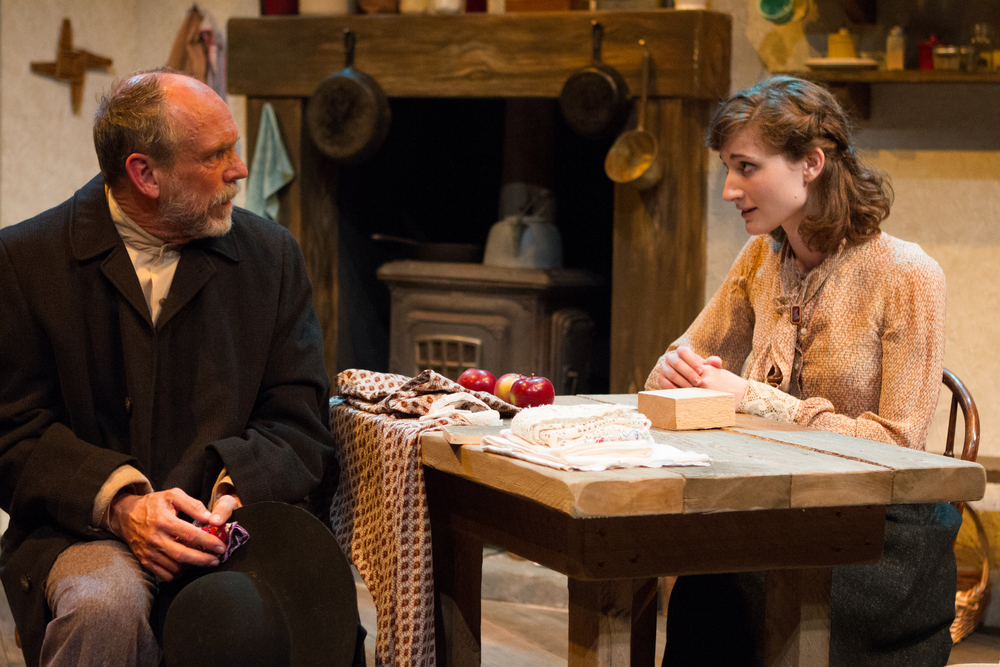
David Bunce and Hallie Christine ’15
While there were countless moments of acting brilliance, Friel’s poetic language was also embodied through the work of the design team. The scenic design of the production embodied the polarizing worlds of Michael’s lush imagination and the slowly crumbling Mundy household. Scenic designer Greer Duckworth ’15 emphasized the importance of creating the two separate worlds, but also having them cohesively coexist. Duckworth truly excelled when it came to fine tuning details–having the wood chips lining the entrance as the audience walked in, the stones clearly crumbling around the house, and even the meticulous details of the floor and wall patterns helped to create the challenging specificity of historical, impoverished Northern Ireland in the 1930s.
The ingenuity of the design team for this production extended beyond just a expertly thought-out and constructed set. Lighting designer Noah Samors ’15 and sound designer James Kuzio ’15 both also excelled in their ability to bring aspects like Michael’s memory and “Marconi,” the finicky radio in the Mundy household, to life. It was no simple feat to allow the adult aged Michael to live in a world among his past seven-year-old self. However, Samors made this possible by having nothing in Michael’s memory too vividly lit, but rather kept it warm and fuzzy. This aura created a stark difference between Michael’s memory and his narration, which had hard, dynamic lighting. Furthermore, Samors decision to highlight Jack’s storytelling with a red and orange aggressive, tribal-like light helped set a separate and unique atmosphere when contrasted with the Catholic Mundy household. Additionally, Kuzio did a phenomenal job bringing life to the honorary ninth member of the cast, “Marconi.” This highly specific old time sound aided in willing the suspension of disbelief and maintaining the world that the actors, directors, and designers alike worked to create.
Although the design team’s ability to create the world of the play was undeniably impressive, it would be a disservice to not mention the dancing that helped make this production come to life. Dance consultant Terri Hughes and choreographers Mary Harney and Mary DiSanto-Rose did a wonderful job of combining the characters’ long-suppressed freedom of expression and traditional Irish dance. When the actors dance, the audience is made privy to honest expression and the characters long awaited release of inhibitions.
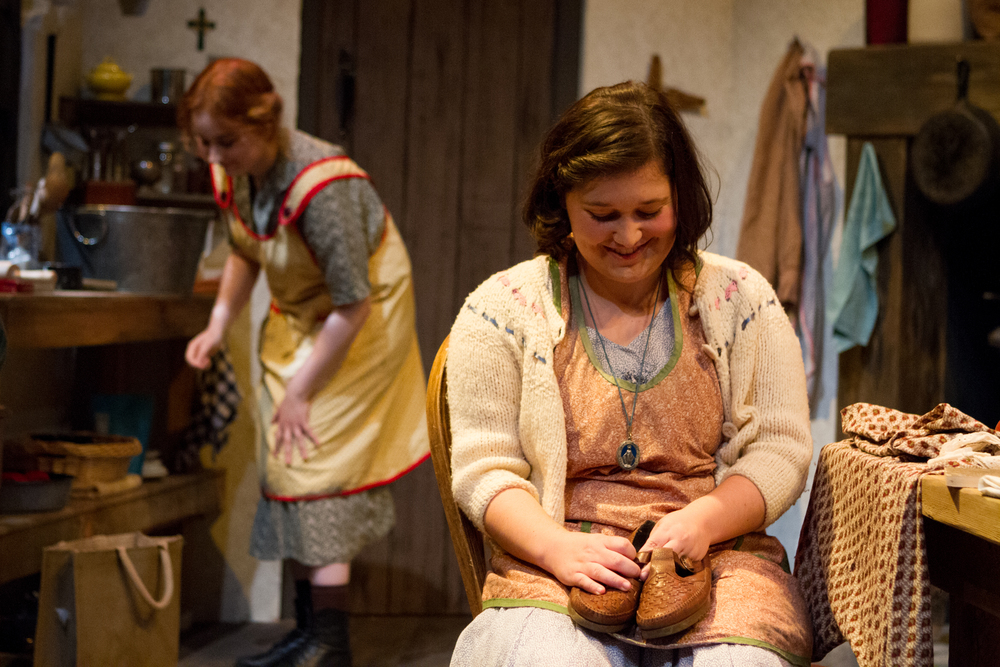
Lily Donahue ’15 and Sierra Fritz ’17
Glotzbach and her assistant directors Emily Moler ’15 and Joan Lawson ’15 all reinforce the importance of bringing this play to Skidmore’s theater community. This play not only forces the audience to connect with these passionate and struggling characters, but it also teaches the audience against the backdrop of the pagan festival of Lughnasa. Glotzbach notes the festival’s association with the “fertility of the harvest, sexual awakening, and rebirth” which are all key themes of the production. She goes on to explain “Friel’s play uses dancing and music to explore important themes of personal identity, Irish cultural identity, historical change, and pagan ritual.” From these statements it is clear to see the wealth of information and thought-provoking material this play can invoke.
Dancing at Lughnasa was a compelling and transformative show that framed the importance of family and allowing oneself to thrive in the present, despite the uncertain past or future. Glotzbach puts it best when she said: “We are complicit as we share this tragic and yet joyous journey.” The audience remains so involved because it is difficult to find the right words to describe the complex journey the Mundy family takes in this two-hour work of art. Although Friel’s characters eventually went their separate ways—and this production has come to a close—the footsteps of that summer in the Mundy home and of and this show will forever echo in the black box theater and continue, in Michael’s words, “dancing as if language no longer existed, because words were no longer necessary.”
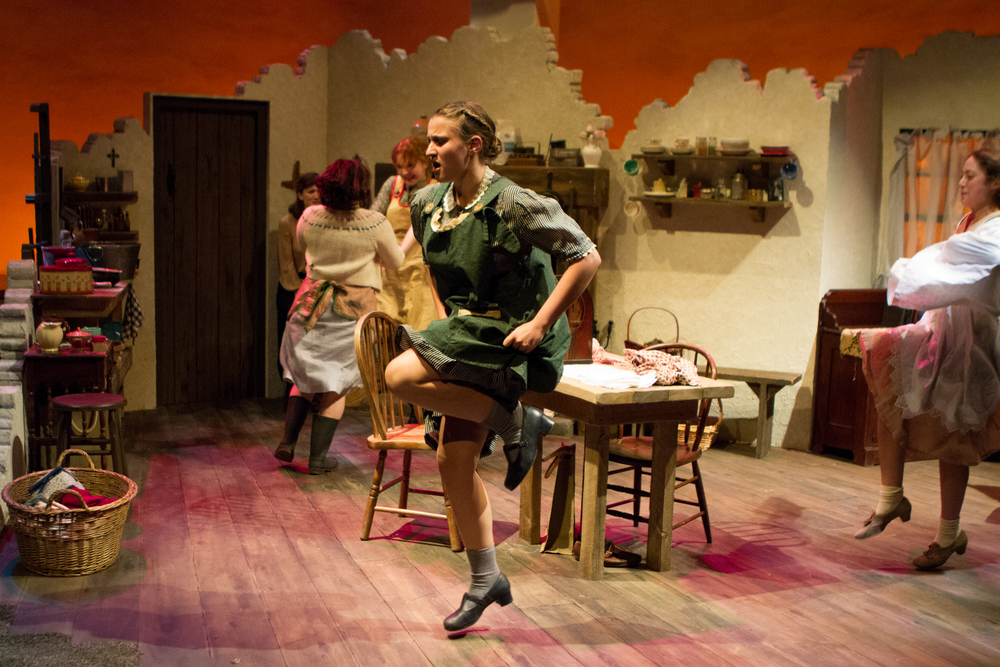
Rebecca Zipursky ’15, Photo credit: Julian Klein ’15
This article originally appeared in print in the Fall 2014 Skidmore Theater Newsletter.
